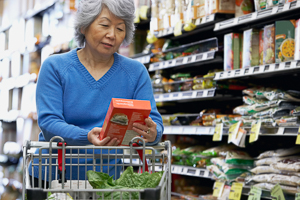How to Find Sodium
Topic Overview

Almost all foods contain sodium, or salt, naturally or as an ingredient. But you don't always know it's there, or how much is there. Here are some tips to help you find sodium.
Know what "low sodium'' means
Labels on foods often claim that the food is "low-sodium" or something similar. Learn what these claims mean:
- "Unsalted" means there is no sodium added to the food. But the food may still contain sodium naturally.
- "Sodium-free" means a serving has less than 5 milligrams (mg) of sodium.
- "Very low sodium" means a serving has 35 mg or less of sodium.
- "Low sodium" means a serving has 140 mg or less of sodium.
- "Light sodium" and "reduced sodium" mean that there is 25% less sodium than what the food normally has. This is still usually too much sodium. Try not to buy foods with either of these on the label.
Count milligrams of sodium
You can limit sodium in your diet by counting the milligrams of it in everything you eat. This method allows more flexibility in your diet. If you eat one high-sodium food, you can balance it with very low-sodium foods during the rest of the day.
To count the milligrams of sodium, read the Nutrition Facts on food labels. You'll learn which nutrients are in the food, including sodium. Look at both the serving size and the sodium amount.
- The serving size is found at the top of the label, usually right under the "Nutrition Facts" title.
- The amount of sodium is given in the nutrient list. It is given in milligrams (mg).
- Check the serving size carefully. A single serving is often very small, and you may eat more than one serving. If you do, you will eat more sodium than listed on the label.
- For example, let's say the serving size for a canned soup is 1 cup and the sodium amount is 470 mg. If you have 2 cups of soup, you will eat 940 mg of sodium.
You may want to keep a sodium record. This can show you how much sodium you eat at a meal or during the day. If you have heart failure, keep a record that allows you to also record your weight (What is a PDF document?).
Find hidden sodium
Sodium can be found in many substances. Many canned and other processed foods and some medicines can contain sodium.
Hidden sodium in foods
Check the ingredient list on food labels for the word "sodium." Be careful about using products that have these ingredients:
- Monosodium glutamate, or MSG (often added to Chinese food)
- Sodium citrate
- Sodium sulfite
- Sodium caseinate
- Sodium benzoate
- Sodium hydroxide
- Disodium phosphate
Sodium in medicines
Check your medicines. Sodium may be an ingredient.
- Prescription medicines. Talk with your doctor about whether the medicines you take contain sodium.
- Nonprescription medicines. Many medicines that you can buy without a prescription contain sodium. Read the labels. If you aren't sure if a medicine contains sodium, talk with a pharmacist. Be sure to check with your doctor before taking any new nonprescription medicine.
Health Tools
Health Tools help you make wise health decisions or take action to improve your health.
Related Information
Credits
ByHealthwise Staff
Primary Medical Reviewer Kathleen Romito, MD - Family Medicine
Specialist Medical Reviewer Rhonda O'Brien, MS, RD, CDE - Certified Diabetes Educator
Current as ofMarch 29, 2018
- Top of Page
Next Section:
Health Tools
Previous Section:
Topic Overview- Top of Page
Next Section:
Related Information
Previous Section:
Health Tools- Top of Page
Next Section:
Credits
Previous Section:
Related Information- Top of Page
Current as of: March 29, 2018
Author: Healthwise Staff
Medical Review: Kathleen Romito, MD - Family Medicine & Rhonda O'Brien, MS, RD, CDE - Certified Diabetes Educator